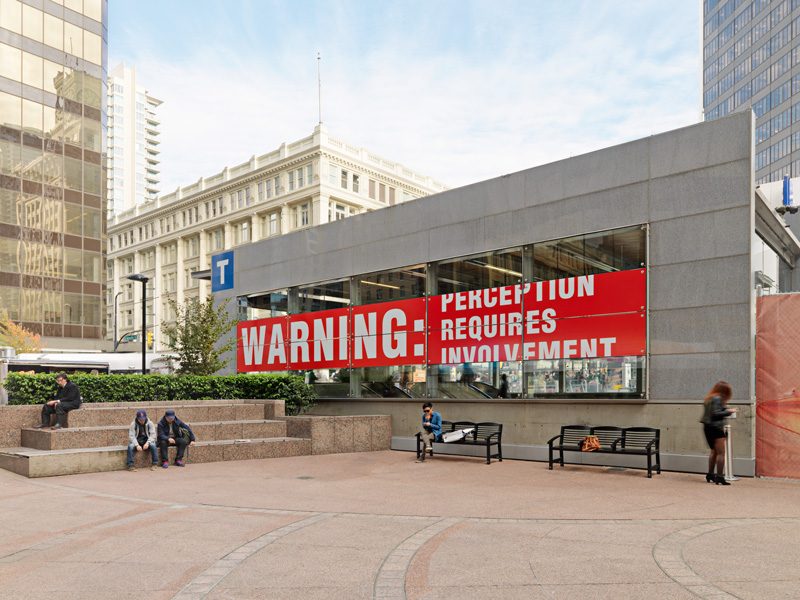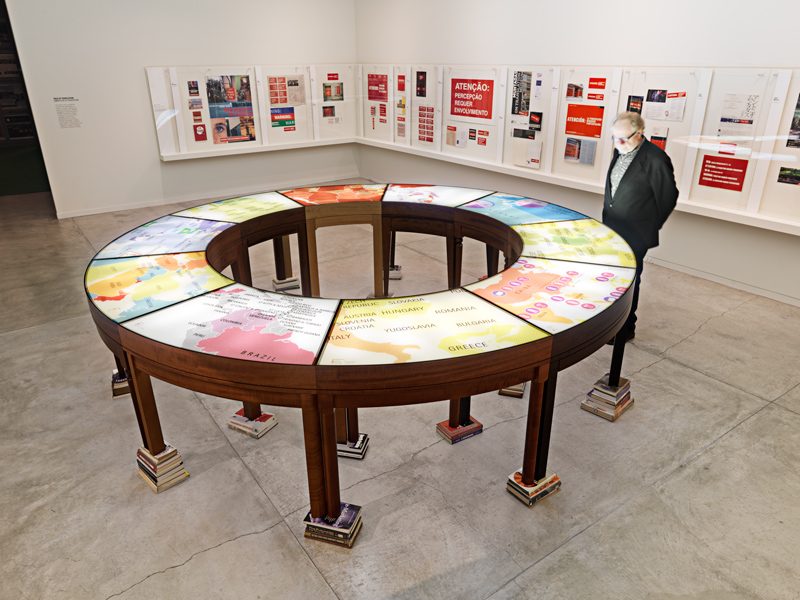Vancouver Art Gallery, Vancouver
9 November 2013 to 10 February 2014
By Karen Henry
Warning: Perception Requires Involvement, in bold white text on a red background, covers the wall of the Canada Line transit station in downtown Vancouver. It is both a statement about the commitment needed to understand something and a public warning about the tendency these days to limit the onslaught of information to what can be gleaned in a ten-second media clip or an advertising image. The statement is also an introduction to the work of Antoni Muntadas at the Vancouver Art Gallery.1 It prompts the audience to consider the implications of involvement and, by association, the precious commodity of time. Time is a significant factor in Muntadas’s work. He works in time-based media, and his pieces evolve over time. On Translation: Warning (1999–on-going) has been shown in public contexts around the world in a number of languages, as signage, printed cards, and in media variations. The fifteen-year project is indicative of the artist’s commitment to communication and the concurrent expectations of the audience.
If perception/involvement is the pillar of Muntadas’s practice, the foundation is in the 1970s art/life movement. In the early 1970s, Muntadas moved from Franco’s Spain to the United States, where he established the exploratory view of the outsider, and his early career developed in step with time-based media and conceptual practices of the time. His subjective view was established in an early work, Confrontations (1974), which explores three New York City boroughs through two media: three video monitors and three slide projectors compare both technologies and social context.
The exhibition includes early video and film “tactile proposals,” such as exploring spaces blindfolded, and mobile performative structures, such as an extended flexible tube. The camera is key to these experiments. Video, with its documentary, activist, and performative character, became a primary working method for Muntadas early on. In Acción TV (1972), he is shown with the letters “T” and “V” over his closed eyes, implicating television both as a part of personal and public identity and as how one sees the world.
Later works expand on the personal– public dichotomy, including a 1979 series of collages from Vancouver (in collaboration with Hank Bull) that was shown at the Vancouver Art Gallery in that year. Muntadas has a long history with this city and also produced part of Between the Frames (1983–93) at the Western Front in the mid-1980s. This work is a classic video installation from the period, with a circle of Sony Trinitron monitors on plinths. The work is composed of eight chapters and is an engaging mix of perspectives, languages, places, and personalities that (still) drive the art world.
In an online video interview produced for this exhibition at the Jeu de paume, Muntadas says that in the 1970s he decided to work in three overlapping spheres, art, social science, and communications systems, “but the landmark is art.” Artworks are the “devices and systems” of engagement, the architecture through which the audience enters into the exploration.
The exhibition is organized as a series of nine overlapping “thematic constellations” – Microspaces, Media Landscape, Spheres of Power, Communal Spaces, Places of Spectacle, Domain of Fear, Field of Translation, The Archive, and Systems of Art. This attempt to focus territories is quickly subsumed in the volume and complexity of visual and audio information. The viewer is left with the artist’s commitment to intellectual observation elaborated through critical subjectivity, media, and the critique of power. The Board Room (1987) remains a powerful presentation, with its red carpet, subdued lighting, and portraits of powerful twentieth-century religious figures, each portrait with a small video “mouthpiece” providing context within this nexus of power. These icons themselves are formed of graphic pixelated media images. Media runs through the exhibition as a whole as intrinsic to global culture. On Translation: The Negotiating Table (2005) is a circular table that charts the spread of media into countries and households. The three-channel video projection On Translation: El aplauso (1999) implies that the audience indiscriminately colludes in the spectacle.
The bulk of the work addresses monolithic media systems that cannot be said to be as powerful in today’s dispersed information economy, in which skepticism is well entrenched. What does perception/ involvement mean today? Muntadas’s work sets out the complex fabric of social networks and power relations, but stops short of a call to arms. One wonders whether that is enough in the world of Idle no More and the Occupy movement – whether this century requires a more active approach to involvement.
The File Room (1994 and ongoing at thefileroom.org) enters the interactive territory of the Web. It is an open archive of censorship that invites input from the public. More recently, Muntadas has explored the phenomenon of fear through the concentration by the media on terrorism and the protectionism of the moneyed class. Alphaville Y Otros (2011) is an immersive installation that uses the Godard sci-fi movie as a point of reference for a visual exploration of the proliferation of gated homes and communities in Brazil and elsewhere – an evolution of the public-and-private discussion.
One outcome of Muntadas’s commitment to audiences over time is that the works continue to evolve and provide context for elaborating and further prodding systems. A work not included in this exhibition is On Academia (2011), created for MIT and Harvard but recently installed at Simon Fraser University in Vancouver. It was used as a context for essays, talks, and discussions on the role of this institution in this place and time.
The works in Entre/Between present the artist as a principled observer, reframing representation, investigating broadly the systems of power that move the world. Muntadas is in between the subject and the audience, translating through his extensive experience of the world. This moment, between the twentieth century and the full force of new systems in the twenty-first century, seems right for a survey of this work. The exhibition, organized by curator Daina Augaitis, holds up well to the rigours of the work, presenting critical subjectivity as its foundation.
Karen Henry is a curator, writer, editor, and, currently, public art planner in Vancouver.


